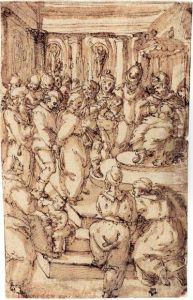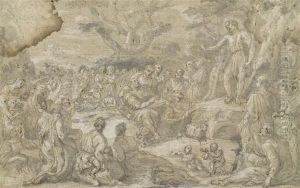Cesare Franchi Paintings
Cesare Franchi, also known as Il Pollino, was an Italian painter of the late Renaissance period, active mainly in Florence. Born in 1555, his artistic journey began in the vibrant cultural and artistic milieu of Florence, a city that was a crucible for the Renaissance movement. Franchi's work is characterized by its devotion to the principles of the High Renaissance, infused with a mannerist sensibility that was prevalent among his contemporaries. His paintings often depicted religious themes, imbued with a sense of grace and elegance that was typical of the late Mannerist period.
Franchi received his initial training under the guidance of Santi di Tito, a prominent Florentine painter who was instrumental in steering the artistic direction of the late Renaissance towards a more classical and harmonious approach, as opposed to the extravagances of Mannerism. Under the mentorship of di Tito, Franchi honed his skills, developing a keen eye for composition, color, and the human form. His works, though not as widely recognized as those of his master, display a mastery of the techniques that were celebrated during his time.
Throughout his career, Franchi remained closely tied to the artistic circles of Florence, contributing to various projects and commissions that were indicative of the city's rich artistic legacy. His contributions to the decoration of several Florentine churches, including frescoes and altar pieces, are testament to his skill and versatility as an artist. Despite his adherence to the stylistic norms of his era, Franchi's work also displays a unique sensitivity to the emotional and spiritual dimensions of religious art, setting him apart from his peers.
Cesare Franchi's death in 1615 marked the end of a career that, while not as celebrated as some of his contemporaries, contributed significantly to the tapestry of Italian Renaissance art. His legacy, preserved in the frescoes and paintings that adorn the churches and palaces of Florence, continues to be a subject of admiration and study for art historians and enthusiasts alike. Through his art, Franchi encapsulated the beauty and complexity of the human experience, framed within the religious and cultural context of his time.

